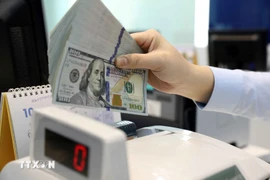1. GDP growth amidst severe global economic downturn
Given the severe global economic downturn caused by COVID-19 in the year, Vietnam is among very few countries to post GDP growth, estimated at 2.5-3 percent. This is attributable to the flexible management of the Government and the determination of the entire political system to complete the dual goals of containing the pandemic and maintaining economic growth. The result creates a crucial foundation for the country to fulfil socio-economic targets during the 2021-2025 period.
2. Vietnam – founding member of the world’s largest free trade agreement area
The RCEP agreement was officially signed on November 15, within the framework of the 37th ASEAN Summit organised by Vietnam as ASEAN Chair 2020. The pact is expected to create the world’s first-ever largest free trade agreement area with combined GDP of 26.2 trillion USD or around 30 percent of the global GDP and nearly 28 percent of the global trade. Apart from RCEP, the EU-Vietnam Free Trade Agreement officially came into force since August 1, which has opened up many strategic trade cooperation for Vietnam in the time ahead.
3. Huge losses caused by natural disasters
The year 2020 witnessed unusual, extreme weather patterns, notably the historical flooding in the central region. Up to seven storms continuously ravaged the region in October and November, with the ninth – Molave - the most destructive storm over the past two decades. The total damage caused by natural disasters in the year was estimated at 38.4 trillion VND (1.66 billion USD), with up to 31.7 trillion VND by floods and storms.
4. Programme on national digital transformation approved
The Prime Minister on June 3 signed Decision 749/QD-TTg approving the national programme on digital transformation until 2025, with a vision toward 2030. This is the first time, the Government has issued a decision on national digital transformation, with the aim of developing a digital government, economy and society and establishing Vietnamese digital technology enterprises that can go global. Under the programne, the digital economy is expected to make up 20 percent of the country’s GDP and Vietnam is expected to enter the world’s top 50 countries in the Global Competitiveness Index (GCI) by 2025.
5. Trade surplus hits record high despite COVID-19
Although the COVID-19 pandemic has severely disrupted the global supply chain, Vietnam’s exports still maintained high, hitting the record of some 20 billion USD. In 2020, 31 groups of commodities joined the over 1 billion USD club in export revenue, making up 92 percent of the total export value. Of them, six posted export revenue of over 10 billion USD.
6. Public investment disbursement grows strongest in decade
Public investment disbursement has been stepped up in the year and projected to exceed 90 percent of the set target, the highest in the 2011-2020 period. Since the beginning of this year, the Government has regarded public investment as a major resource to spur national economic growth.
7. Central bank cuts cut policy rates for three times
2020 marked the first year when the State Bank of Vietnam had slashed policy rates for three times, by 1.5-2 percent per annum. The adjustment has supported liquidity for credit institutions, lowering borrowing costs for people and businesses.
8. Number of dissolving firms surge
The COVID-19 pandemic is seen as the most formidable challenges to the business community. A total of 93,500 enterprises ceased operations, waited for dissolution procedures and completed dissolution procedures during January-November, a year-on-year increase of 15.6 percent. Most of the companies operated in the fields of catering, real estate, brokerage service, logistics, among others. The increase in dissolving businesses makes the Government’s target to have at least 1 million enterprises by 2020 unfeasible.
9. Stock market – an important channel for capital mobilisation
After 20 years of operation, the Vietnamese stock market has developed in both scale and quality, and become an important channel to mobilise mid- and long-term capital, making significant contribution to the economy. As of November 30, the country’s stock market capitalisation had hit over 6.11 million USD - the highest level ever, accounting for 101.33 percent of the GDP and surpassing the target of 70 percent as set in the stock market development strategy by 2020.
10. Aviation, tourism suffer heavy losses
2020 is a tough year for the aviation and tourism sectors due to the COVID-19 pandemic. The outbreak drove national flag carrier Vietnam Airlines loss of more than 15 trillion VND (649.6 million USD), while Vietjet Air, Bamboo Airways and Pacific Airlines reported tens of trillions of Vietnamese dong in loss. The coronavirus also wreaked havoc on the tourism sector, with the number of foreign visitors dropping 80 percent and that of domestic travellers slipping nearly 50 percent. Total loss was estimated at 530 trillion VND./.



















